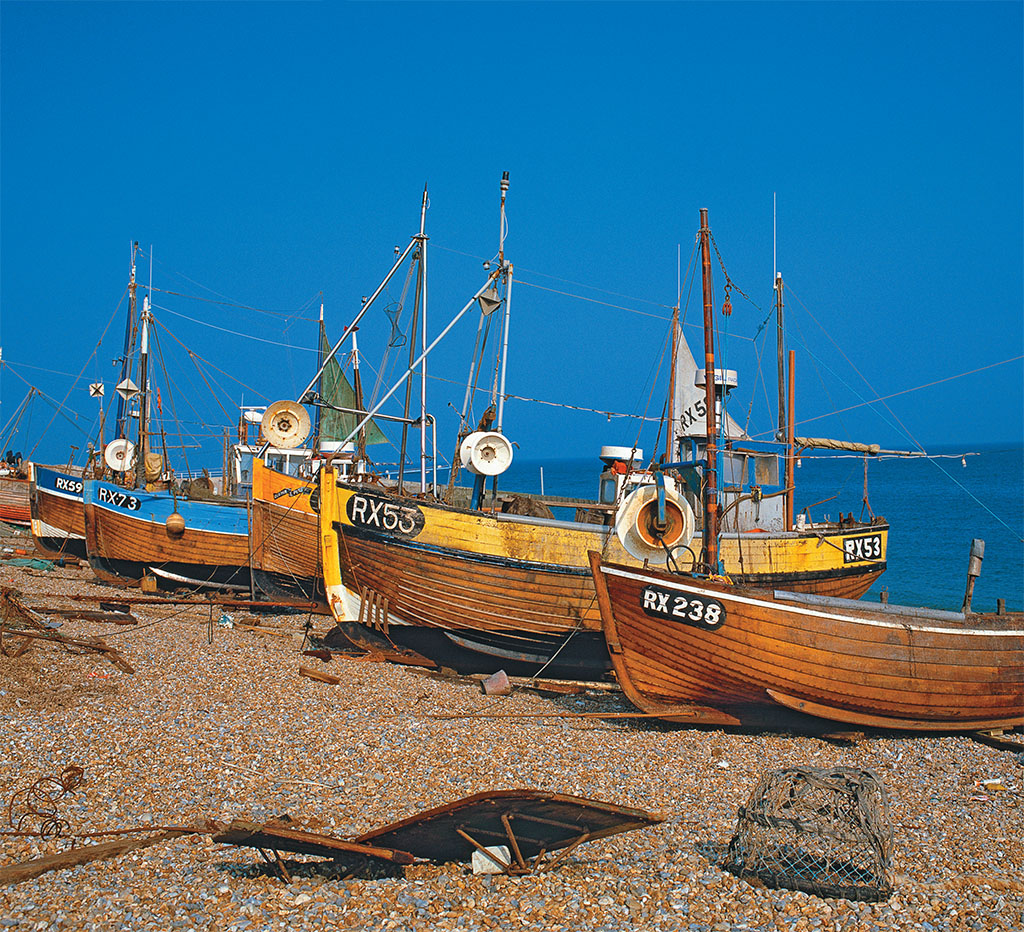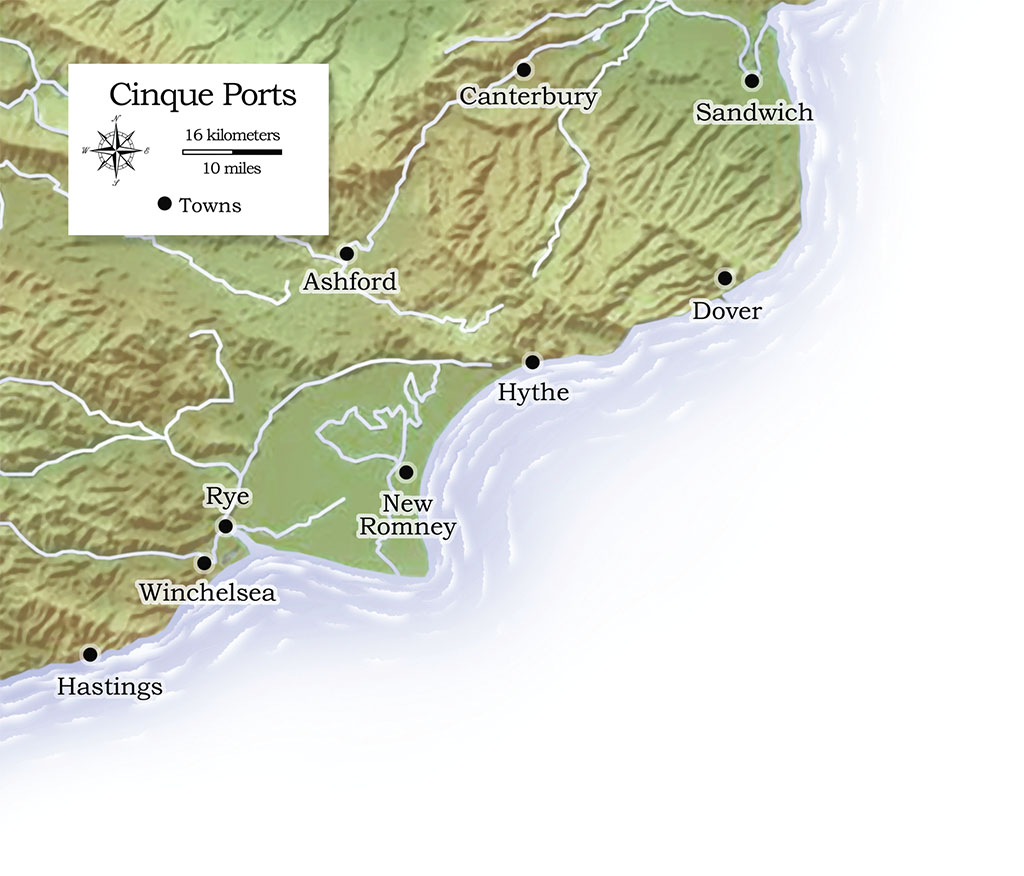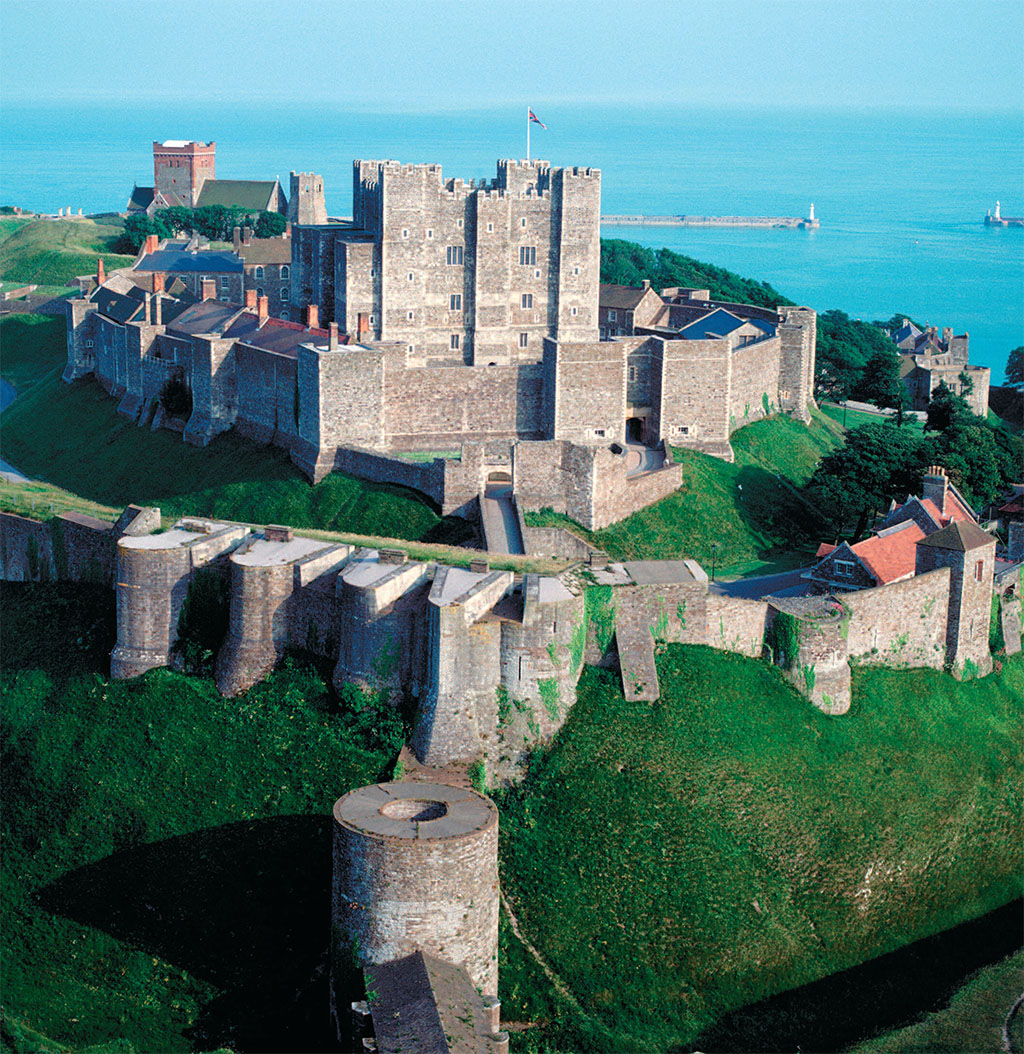
From medieval protection line to jewels of tourism in the south of England, the Cinque Ports continue to watch over the peace of the realm
[caption id="FamousFiveKeepingGuard_Feature" align="aligncenter" width="1024"]

©DPICS/ALAMY
MANY OF BRITAIN’S most picturesque ruins, time-mellowed and well-worn as they are, charm precisely because of their peaceful face and air of friendliness. Yet, when they were thrown up by Norman labor or medieval planners, they were meant for war and defense. Tranquil thoughts and contemplation were the last things on the minds of the builders.
The Cinque Ports (Norman French for five ports, pronounced “sink”), a necklace of coastal towns in Kent and Sussex at the eastern end of the English Channel, are a case in point. Visit any of these picturesque towns and you can easily forget their military past. Located where the crossing to the continent is narrowest and most vulnerable, they were united for military purposes as a medieval DEW line to protect the king of England from the clear and present danger coming from mainland Europe.
Now the five—Hastings, New Romney, Hythe, Dover and Sandwich—welcome the visitor and face out to a much changed world, swapping their hard-faced defensive role for the modern tourism industry.
[caption id="FamousFiveKeepingGuard_img1" align="alignleft" width="1024"]

GREGORY PROCH
Like much British history, the origins of the Confederation of Cinque Ports, the official title of the united ports, is clouded in the murky mists of the past. There is no agreed date of its formation, with scholars disagreeing over dates ranging from 1,000 years ago, before the Norman invasion, to the 13th century.
What few disagree on, however, is the reason the confederation was created. A word, which came into common use at the same time as the DEW line, sums up the reason: realpolitik, where politics are predicated on practical rather than moral or ideological considerations. The five ports were given considerable freedoms, especially from import duties, in return for supplying the king with ships and sailors to defend the nation as well as protecting merchant shipping crossing the English Channel and Dover Straits.
Some historians consider this military draft the foundation of the Royal Navy, a lineage that leads directly to the creation of the British Empire based on naval power.
WINNERS AND LOSERS
While membership in the confederation imposed military demands on the townsfolk, for a number of citizens it conveyed some very special privileges: one was the cherished right of bearing the canopy held aloft over the monarch’s head as he or she walked in procession at the coronation at Westminster Abbey. The Coronation Barons of the Cinque Ports would walk solemnly in procession, then be rewarded with a place of honor at the subsequent coronation banquet inside Westminster Hall. There they sat at the banqueting table on the right hand of the monarch. The last time the honor was enjoyed was the coronation of George IV in 1821.
In fact, the privileges enjoyed by the movers and shakers of the Cinque Ports read almost like a medieval “get out of jail free” card.
There was exemption from tax and tolls; the right of sac and soc or self-government; the right to inflict pillory and tumbrill as punishment for minor offences; the right of team to compel holders of stolen goods to divulge their source; flotsam and jetsam, the power to claim floating wreckage on the shore or goods thrown overboard; the right of blodwit and fled-wit, the authority to punish shedders of blood and seize those who fled from justice.
These privileges had to be paid for: Under the system of “ship service,” the ports were required to supply 57 armed ships, each with a crew of 21 men and a boy, for 15 days every year. These ships were used not only in warfare, but to provide transport for the king, his retinue and armies to and from Normandy and elsewhere on the continent.
This was an onerous duty and the five original ports had to enlist neighboring towns and villages to help them fulfill their quotas of ships and crew. These towns and villages became known as members or “limbs.”
Some of the limbs were merely small villages and hamlets. These ancillary members negotiated directly with their “head” port to provide ships and men. In return, they were given the right to share in the privileges granted to the head port.
At one time, there were actually 23 limbs covering an extensive area from Seaford, in the west, to Brightlingsea on the Essex coast. Originally, Rye and Winchelsea were limbs of Hastings; as its harbor silted, however, Hastings could not fulfill its obligations and relied increasingly on its major limbs. Rye and Winchelsea were eventually admitted as full members of the confederation.
Hold the Mayo!
It stretches the imagination to believe that John Montague, 4th Earl of Sandwich (1718-1792), ordered his flunkeys to put sliced cold meat between slices of bread and invented the fast food forever associated with him—the sandwich. More believable was his desire not to interrupt his gambling sessions. While he cannot have been the first to have ever enjoyed a sandwich, his name soon stuck—fashionable dandies of the time ordering “the same as Sandwich!” when hungry. In fact, the family of the Earls of Sandwich has no real connection to the town. The 1st Earl, Edward Montagu, originally intended to take the title of the Earl of Portsmouth. He may have changed his mind as a compliment to the town of Sandwich because the fleet he was commanding in 1660, to bring Charles II back to England, lay off Sandwich before sailing.
[caption id="FamousFiveKeepingGuard_img2" align="aligncenter" width="1024"]

©SKYSCAN PHOTOLIBRARY/ALAMY
Given the importance of the confederation, it was natural that it acquired a titular head in the 13th century—the Lord Warden and Admiral of the Cinque Ports and Constable of Dover Castle. Once it was one of the most powerful positions of state, but now it is simply honorary.
When Normandy was lost to the English crown in the 1200s, the danger moved to the English coast and the need to firm up defenses was acknowledged. While each port had its own “custodies” or “warden,” it was recognized that unified control was needed. From the wardenship of Stephen de Pencestre (1265-92), the offices of Constable of Dover Castle and Lord Warden of the Cinque Ports were combined and held by the same person.
A century later, an admiralty court was founded for the Cinque Ports as the Admiral of the Cinque Ports was responsible for mustering the fleet and exercising discipline.
Some of the most important people in the Kingdom have held the position: the princes who went on to become Henry V and Henry VIII, William Pitt, the Duke of Wellington, Sir Winston Churchill and the sole female holder of the position (from 1979 until her death in 2002), Queen Elizabeth the Queen Mother.
South African-born Admiral Michael Cecil Boyce is the present Lord Warden. He is a cross-bench member of the House of Lords, a former First Sea Lord of the Royal Navy and Chief of the Defence Staff. He assumed the office in June, 2004.
THE UNKIND COAST
The English coastline has not been kind to the Cinque Ports over the centuries. It has not been the French that has done the most damage; it has been the shingles clogging up the rivers that have spelt doom for four of the ports. To this day, the mayor of Dover still retains the right to summon by drum every householder to go with a shovel and remove shingle from the harbor.
Now Dover alone remains a working port on the coast: all the others are no longer ports at all. Romney and Hythe have built new settlements southward as the sea retreated.
The lack of seashore need not put off the visitor as each town still retains many attractions. In Hastings, the largest beach-based fishing fleet in Europe can still be seen, with sea-fresh fish still available from the boats. The stretch of shingle beach from which the fishing fleet launches has been known as “The Stade” (the Saxon term for “landing place”) for more than 1,000 years. The town’s East Hill lift is the steepest funicular railway in the UK, while remains of the Norman castle on West Hill still stands guard.
In Sandwich, town walls surround the medieval town, providing a pleasant walk from which the visitor can see the compact pattern of the streets and the unique, ancient, tiled roofs. The town’s Strand Street has what is considered to be the longest continuous stretch of timber-framed buildings in Britain. It used to be the quay for sailing ships.
Follow the New Romney Town Trail to discover some of the stories of this attractive, bustling town. The walk takes about 30 minutes, and there are plenty of places to stop for refreshment!
In Hythe, the defensive role was underlined as late as Napoleonic times with the very visible presence of a Martello tower and the 19th-century Royal Military Canal. A wide promenade overlooks a long stretch of beach, over the English Channel to France—ideal for a summer picnic and safe bathing.
On the seafront the town is on level ground, mostly residential. Hythe then spreads up the hillside in a pleasing jumble of little streets, with many interesting historic buildings. The old and narrow High Street is the main shopping area and has a history dating back centuries.
[caption id="FamousFiveKeepingGuard_img3" align="aligncenter" width="1024"]

©GREG BALFOUR EVANS/ALAMY
Working on the railroad
One of the south coast’s most engaging tourist attractions has to be the Romney, Hythe & Dymchurch Railway (RHDR). Steam-hauled trains on a track only 15 inches in width, this 83-year-old line travels 14 miles along the English Channel on a course that will delight even those with no interest in railroads. The line carries 100,000 passengers each year. Not just a tourist attraction, the RHDR road operates as a public service between the small towns and villages between Hythe and Dungeness. It is under contract to the local council to transport children to and from The Marsh Academy in New Romney; a new station was opened as recently as last year to provide a transport link to the Romney Marsh Visitor Centre.
Fast forward to now, and the clear and present danger from continental Europe is gone. Where once the Cinque Ports guarded the realm, high speed Eurostar trains and speeding motorists hurry to and from the Channel crossing near Folkestone, contemplating the pleasures of blissful holidays free from the fear of foreign military adventures.
Getting there
Three of the ports are easy to access directly by rail from London: trains go from London Victoria, Charing Cross and London Bridge stations to Dover, Sandwich and Hastings in under 120 minutes. Hythe and New Romney can only be reached by car. When exploring the Cinque Ports region, convenient hotel accommodation can be found at Ashford, the location of the Eurostar station to France.
But the towns’ defensive role is barely cold in the locker of history. As late as the 1940s, Kent and Sussex were again redoubts against a dangerous Europe and a stormy world. Dover functioned in the war as a real fortress in a manner the Normans would have recognized. The countryside around the Cinque Ports served as a gun platform to protect the land from air attack as their forbearers protected England on the waves.
The dangers are now of a different order: too much picturesque Kent and Sussex countryside, too many pints of Kentish or Sussex ale and too much delicious seafood plucked fresh from the English Channel. You have been warned.
[caption id="FamousFiveKeepingGuard_img4" align="aligncenter" width="1024"]

©INTERNATIONAL PHOTOBANK/ALAMY





Comments